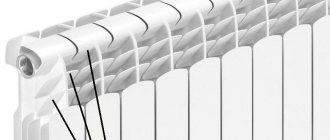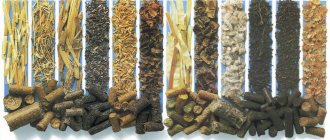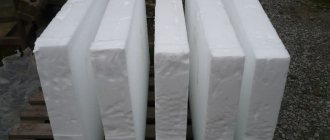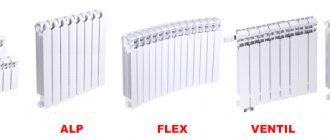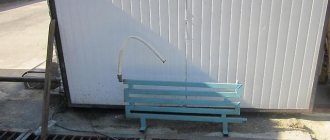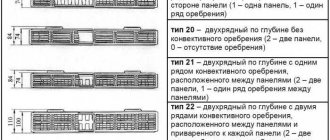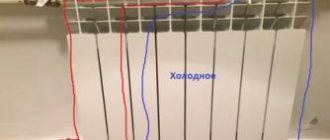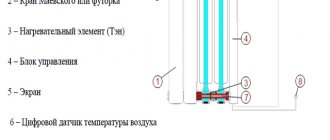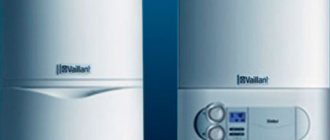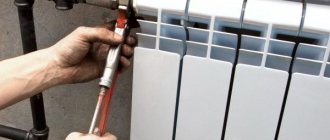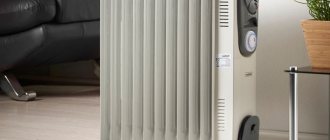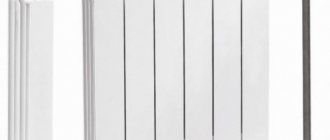Section power
If you are interested in the power of an aluminum heating radiator section, you should read the documents for the device. If the volume is 0.5 liters, then manufacturers usually declare this parameter at 180 W or less. If the temperature of the coolant water varies from 65 to 70˚C, then in reality the thermal power of one section of the aluminum radiator will be less and will be approximately 140 W.
When getting acquainted with the characteristics of the battery, buyers quite often pay attention to the heat transfer conversion formula: ∆t 70°C = 160/200 W. The difference between the average air temperature and the average temperature in the heating system is denoted by ∆t. This suggests that for a ∆t indicator of 70˚C, the air temperature in the room can be 20˚C, and the average temperature in the heating system should be equal to 100˚C, while the return will be equal to 80˚C.
But such figures are quite difficult to achieve in reality. Therefore, taking the power of 1 section of an aluminum radiator, you will have to determine the heat transfer, taking into account the ∆t indicator equal to 50°C. As an example, consider the middle section of the battery with the following dimensions: 100 x 600 x 80 mm. It is capable of heating approximately 1.5 m2 of area, which corresponds to a heat output of 140 to 160 W. When choosing the right number of sections for a room, you should take into account the condition and location of the walls. If the room is corner and one of the walls freezes, this fact should be taken into account.
The right choice
- The performance of heating devices must be 10% of the area of the room, if the height of its ceiling is less than three meters.
- If it is higher, then 30% is added.
- For the end room you need to add another 30%.
Necessary calculations
After determining heat losses, it is necessary to find out the performance of the device (how many kW should be in a steel radiator or other devices).
- For example, do you need to heat a room of 15 m2? and a ceiling height of 3 m.
- We find its quantity: 15•3=45 m?.
- The instructions say that for heating 1 m? in the conditions of central Russia, 41 W of thermal performance is needed.
- This means that we multiply the amount of room by this figure: 45•41=1845 W. The heating radiator must have this power.
Note! If the home is located in a region with harsh winters, you need to multiply this figure by 1.2 (heat loss coefficient). The final figure will be 2214 watts.
Number of ribs
Then you need to calculate the number of sections in the battery. The product manuals indicate the parameter of each edge.
From it you will determine how many kW in one section of the bimetallic radiator and the aluminum analogue - this is 150-200 W. Let's take a large parameter and divide the non-specialized required power in our example by it: 2214:200=11.07. This means that to heat the room you need a battery of 11 sections.
More information about power. Calculation of the number of sections
Knowing the power of one section of an aluminum radiator, you can determine the number of elements. You need to use the following formula: K = S * 100 / P. In it, the letter K denotes the number of sections. S is the area of the room, and the power of one section is denoted by the letter P. If we take into account the average power, which is 150 W, and the area of the room is 25 m2, then the calculation will look like this: 25 x 100 / 150. This will allow you to understand that for efficient heating of a room with the mentioned parameters, 16 sections are needed. Using this formula, you can calculate the volume of the required number of sections to accommodate a particular area.
Heat transfer from heating batteries: what is it, its calculation according to the product data sheet
The amount of heat that is transferred per unit time to a certain volume per unit time is the heat transfer of the heating battery. Heat output is sometimes called thermal power because it is measured in watts.
Sometimes heat transfer is called heat flow power, and therefore you can find the unit of measurement of heat transfer cal/hour in the product passport. There is a relationship between Watts and calories per hour: 1 W = 859.85 cal/hour.
The manufacturer indicates the nominal heat transfer parameter in the radiator passport. Based on this parameter, you can calculate the required number of elements for each individual room or room. If the passport indicates the power of one section is 150 W, then a section of 7 elements will produce more than 1 kW of heat.
Calculation of real heat transfer in kW
To do this, you need to decide on the number of external walls and windows. With one external wall and one window for every 10 m² of room area, 1 kW of heat will be required.
If there are two external walls, then for every 10 m² 1.3 kW of thermal energy will be required.
More precisely, you can calculate the required power using the formula Sxhx41:
- S is the area of the room;
- h is the height of the room;
- 41 is an indicator of the minimum power per 1 cubic meter of room volume.
The resulting thermal power will be the required full power of the heating battery. Now all that remains is to divide by the power of one radiator and determine their number.
Formulas for accurate calculations
KT=1000 W/m²*P*K1*K2*K4…*K7.
The CT indicator is the amount of heat for an individual room.
P - Total area of the room.
K1 is the coefficient for taking into account window openings. If there is a double window, then K1 = 1.27.
- Double glazing - 1.0,
- Triple glazing - 0.85.
K2 - coefficient of thermal insulation of walls:
- Thermal insulation is very low - 1.27;
- Laying walls with 2 bricks and insulation - 1.0;
- High-quality thermal insulation - 0.85.
K3 - ratio of window area to floor area in the room:
- 50% — 1,2;
- 40% — 1,1;
- 30% — 1,0;
- 20% — 0,9;
- 10% — 0,8.
K4 - average air temperature in the room during the coldest period:
- 35 °C - 1.5;
- 25 °C - 1.3;
- 20 °C - 1.1;
- 15 °C - 0.9;
- 10 °C - 0.7.
K5 - accounting for external walls:
- 1 wall - 1.1;
- 2 walls - 1.2;
- 3 walls - 1.3;
- 4 walls - 1.4.
K6 - type of room above the room:
- Cold attic (uninsulated) - 1.0;
- Attic with heating - 0.9;
- Heated room - 0.8.
K7 - taking into account ceiling heights:
- 2.5 m - 1.0;
- 3.0 m - 1.05;
- 3.5 m - 1.1;
- 4.0 m - 1.15;
- 4.5 m - 1.2.
This calculation takes into account the maximum number of features of the room for heating.
Attention! The result must be divided by the heat transfer of one radiator and the result rounded up
About the power of radiator sections of 500 and 350 mm
One section per 500 mm is a standard part of a conventional battery, which is most often found in apartments and houses, as well as offices. Some manufacturers mention in documents that the power of one section of an aluminum radiator can range from 180 to 230 W. The more expensive the products of a particular manufacturer, the higher the heat dissipation of the battery will be. This is why you shouldn’t chase cheap Chinese batteries. In addition, their service life is short.
You can also find a smaller battery on sale, which will come in handy in limited space. This applies to walls with large windows or areas with narrow pockets. The power of one section of an aluminum radiator in this case will be lower, since the coolant used is supplied in a smaller volume and the battery area is smaller. The value described here ranges from 120 to 160 W. The final value will depend on the manufacturer. It is necessary to choose the radiator correctly. After all, if its power is insufficient, then the apartment will be cold, and if you hang a battery with a large number of sections, then you will waste electricity and gas. However, the last factor is relevant only for private houses with appropriate heating systems.
Example of calculating the number of sections
It is planned to install the battery in a room of 20 square meters. m. The room is corner, has two windows and one door. The height is 2.7 m. The radiator will be placed under the window sill (correction factor - 1.04). The boiler supplies coolant at a temperature of 60 °C. At the outlet of the heater, the water will have a temperature of 40 °C.
The calculation for the maximum number of edges is:
Q = (20 * 100 + 0.2 + 0.1) * 1.3 * 1.04 / 72 = 37.56 sections.
Since you need to round to the maximum, you need to install a battery with 38 ribs. It can be divided into two parts and placed under both windows. Each of them will have 19 ribs.
Key Features
When choosing aluminum radiators, you can count on their efficiency and light weight. The latter will not cause any inconvenience during installation and dismantling. To control the temperature, such batteries have a regulator.
To install the device, the technician does not need to have special knowledge and skills. The specific thermal power of one section of an aluminum radiator, according to experience, is the largest among similar devices. Such batteries are very original and presentable, so they can be used not only in ordinary apartments, but also in luxury houses.
Negative reviews
Before choosing an aluminum radiator, you should read consumer opinions, which are not always positive. For example, some buyers note that water leaks are sometimes noted at intersectional joints. The heat distribution in such batteries is uneven. It focuses on the ribbed surface.
Buyers also do not like the fact that the convection return is very small. Such a battery may not last long - up to 15 years. But some manufacturers have corrected this shortcoming by increasing the warranty to 25 years. Buyers quite often refuse aluminum radiators for another reason that they are chemically reactive, so corrosion is a serious enemy for these devices. But manufacturers introduce anti-corrosion treatment into the production process, covering the surface with a layer of oxide film.
Manufacturing Features
Once you know the power of a 500 mm aluminum radiator section, it is important to inquire about other characteristics, for example, the method of manufacturing the battery. Such devices are made by casting or extrusion technology. The first method provides that all sections are manufactured separately. The device ends up being quite durable, since the components include silicon additives (about 12% of the total volume).
The casting process is carried out under high pressure. This method allows radiators to be made in a variety of shapes. Such batteries can withstand operating pressure from 6 to 16 atmospheres. The water channels are slightly widened to allow water to flow as freely as possible. The walls are durable, as they have a fairly impressive thickness.
The power of 1 section of a 500 mm aluminum radiator is not all that you should know about such a device if you are planning to purchase it. For example, the final performance is influenced by the manufacturing method. Battery production can be carried out using the extrusion method. This method involves the use of extrusion. All radiator components are manufactured separately and then fastened together.
The collector is cast from silumin, all parts are well pressed and firmly connected. The extrusion method is cheaper than casting, but the radiator cannot be improved during operation.
Types and method of production
Since aluminum is a fairly soft metal, it is not used in its pure form for the manufacture of radiators. In order to provide the devices with strength, the alloy is diluted with special silicon additives, and the resulting mass is used for the production of both individual sections and collectors.
Much more often, two main methods are used in production:
| Casting |
|
| Extrusions |
|
Let's look at the 500 by 80 radiator type - what it is:
- 500 mm – distance between the centers of the collectors;
- 80 mm – width of one section.
Anodized type battery
- The production process of products of this type is quite complex.
- For the manufacture of such batteries, excellent purified aluminum is used.
- Finished radiators are anodized, thereby changing the structure of the metal, which increases its resistance to corrosion.
- In order to increase heat transfer, the internal space of the radiators is made completely smooth. This result can be achieved by the fact that all parts of the radiator are connected from the outside with couplings.
Thanks to a special metal processing method and internal structure, such devices are able to withstand extreme loads reaching 70 bar. But not every consumer can afford their price.
Features of anodized aluminum radiators
What is the power of the aluminum radiator section, you now know. But before purchasing a heating device, it is important to inquire about the technology used to make the battery. If you have an anodized aluminum radiator in front of you, then you should know that the material undergoes better cleaning during the production process. This allows you to slightly change the structure of the metal. Anodized radiators, unlike pure aluminum ones, are almost resistant to corrosion. The individual parts are connected to each other by couplings, and not by nipples. These couplings are located outside the heating device.
Anodized aluminum batteries are smooth inside, which contributes to higher heat transfer rates. In addition, such devices are able to withstand higher operating pressures. It can reach 70 atmospheres. However, annotated aluminum radiators belong to a more expensive price category than simple ones. However, the latter have worse performance characteristics.
Technical parameters of aluminum radiators
Distance between collectors (axes)
The names indicated on radiator packages always contain a number indicating the center distance. As a rule, these values are standard and equal to both 200 mm and 350 mm, and 500 mm. However, other radiators are also produced, in which the distance between the collectors varies from 200 mm to 800 mm.
Tip: before purchasing a device, you should measure the height of the area located between the window sill and the floor where it will be installed.
Aluminum and bimetallic radiators 500 are not recommended to be mounted close to any surface. This can significantly impede the circulation of hot air, resulting in reduced battery efficiency.
Advice: when installing a heating system radiator, you need to ensure that there is at least 100 mm of free space from the window sill and floor to the radiator. The radiator should also be separated from the wall by a space of about 30 mm.
Aluminum heating radiators 500 by 100 - for autonomous heating systems with a section width of 100 mm
About thermal parameters
A significant part of the heat exchange of a radiator is radiant heat exchange or radiation. The rest of the heat is transferred to the air through convection or mixing of air masses. Due to the special structure of the heating radiator, i.e. ribbed surface, heat transfer is significantly enhanced.
Heat exchange
An aluminum radiator heats a room in two ways:
- heat transfer – indicated in the product passport in watts. To calculate the total parameter value for a heating device, you need to multiply the power of the aluminum radiator section 500 by their number in the battery;
- convection.
Due to the high degree of heat transfer, radiators have low inertia. This means that they do not need to heat the coolant to a high temperature, and this, in turn, protects the boiler from wear.
Lifetime
Almost all manufacturers of aluminum radiators guarantee consumers that their products will serve faithfully from 10 to 20 years. More well-known manufacturers add another 5 years.
However, the device can last much longer. You just need to periodically inspect it and eliminate all flaws in a timely manner. Depending on the selected model, the technical parameters of the radiators are approximately as follows:
- the length between the centers of the supply pipes or axes is 200 mm, 350 mm, and also 500 mm;
- system pressure – 6-16 bar;
- heat transfer or power of aluminum heating radiators 500 per 1 section – 82 W-212 W;
- section weight – 1 kg-1.47 kg;
- section capacity – 250 ml-460 ml;
- the highest degree of heating is 110°C;
- Guaranteed service life – up to 15 years.
The most famous manufacturers
The rating of bimetallic heating radiators 500 to 80, just like aluminum ones, is constantly changing; today the most in demand are:
- Faral – this manufacturer supplies two types of radiators from Italy to Russia, one of which is Faral Green HP, and the other is Faral Trio HP. The distance between the collectors is 500 and 300 mm. When assembled, the number of radiator sections varies from 3 to 16. In this case, they are fixed to each other using nipples.
The photo shows a Faral heating device
- Kalidor - these batteries, like the previous ones, are produced in Italy, the use of the latest technologies has significantly improved the technical parameters of these products. Radiators are characterized by increased heat transfer and resistance to corrosion. The paint coating is applied in a special way, which gives it additional strength.
Rovall manufactures products using extrusion technology
- Rovall – several models from this manufacturer have become particularly popular in Russia. This is due to the wide selection of colors and the robust design of the radiators.
Feedback on features of use
When you know the power of one section of an aluminum radiator, but you still don’t know whether it’s worth purchasing such a heating device, you should familiarize yourself with consumer opinions regarding the operating features. For example, it is recommended to wash such batteries with running water once a year. Before starting operation, it is important to make sure that the radiator is installed correctly and is connected to the system with quick-release connections.
It is impossible to install such devices in the same base as a boiler that has a built-in copper heat exchanger. Consumers emphasize that when copper and aluminum come into contact, a galvanic couple is formed. In this case, copper acts as a strong metal that attracts aluminum ions, turning it into foil over time. Craftsmen emphasize that this law is not applicable to systems made of polypropylene or metal-plastic pipes. In this case, there is no direct contact between copper and aluminum.
